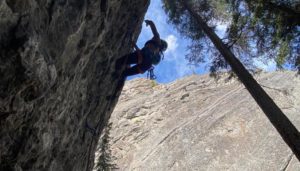Has the Future of Climbing Guidebooks Arrived in Squamish?
A review of KAYA's new digital Squamish bouldering guide and how it's changing the game for bouldering in North America

In late June, KAYA released a digital Squamish bouldering guidebook. Written by Squamish’s original bouldering guidebook author, Peter Michaux, and long-term Squamish developer and KAYA co-founder, Marc Bourguignon, the guide covers nearly 4,000 boulder problems in and around Squamish.
Digital guidebooks aren’t a new concept, but KAYA has taken them to the next level through the savvy use of GPS. In the new KAYA guide, every Squamish boulder is GPS-tagged and every trail to reach the boulders is meticulously mapped in GPS as well. Similar to Google Maps, you simply follow your little blue dot along the trails in the KAYA map to arrive at your desired destination. Each boulder has its own icon that you can tap to look at its topo, read problem descriptions, view community ascent history, and watch user-uploaded beta videos. You can record your sends in the app and look at summary statistics of your climbs over time.
When I first heard Squamish was getting an app-based digital guidebook from KAYA, I must admit my initial thought was “Why?” I had only used KAYA in gyms before and didn’t really understand how it would work outside. Plus, Squamish already has a world-class physical guidebook that came out just last year. I had visions of Squamish’s bouldering areas soon teeming with climbers walking around with their faces glued to their phones, missing out on the beauty of nature around them.
I also just love physical print guidebooks. Poring through them before a trip or big climbing day is one of my favourite things to do. But as much as I treasure print guides, I essentially never bring them outside anymore. I take pictures of the pages I need, or use digital PDF versions of the book if available. I see this approach frequently as books have grown in size over time.
Both of my digital workarounds are a little clunky. The picture-taking method is risky – you never know where you’re going to end up on a climbing day. Many times, I’ve ended up at different crag/boulder than expected and I didn’t have a topo photo. PDF versions of guidebooks are definitely a step up, but they’re also a little tiresome to use. Lots of scrolling and zooming in and out. It’s definitely not an ideal user experience.
My initial, somewhat negative reservations about the new KAYA Squamish bouldering guidebook quickly changed after I tested out the KAYA app and their new guide. The GPS feature is not a gimmick, it’s a total game changer. It makes finding parking, trails, boulders, and problems a breeze. The app is a one-stop shop for everything you need, merging services previously provided by lots of different platforms all into one efficient app.
Unlike my previous digital guidebook workarounds, the KAYA Squamish digital guidebook user experience is top-notch. Yes, you might be staring at your phone instead of a book, but you’re also almost certainly going to save time getting to your desired boulder, and you’re going to stay on-trail while you do it – preventing trail braiding and erosion. KAYA also gives a portion of their revenue back to the Squamish Access Society to promote sustainable long-term access to the Squamish climbing areas we all love.
The KAYA App
Founded in 2019 by a group of climbers, KAYA started as an app for tracking your climbs and uploading send videos. In 2022, they grew into the world of digital bouldering guidebooks. They started with Joe’s Valley and now have guidebooks available for many U.S. bouldering destinations including Red Rocks, Bishop, and Leavenworth, among many others.
If you’re not already familiar with how KAYA works, it has a free version and a subscription-based Pro version, which can be paid monthly or annually. You can download the app here. The free version gets you basic climb info like grades, star ratings, and ascent history. You’re also able to log your climbs – similar in process to other platforms like 8a.nu or Sendage. KAYA also hosts a beta library for each climb. You can upload your own send videos and watch videos of others – no need to go to YouTube.
All of that comes for free, but you get many more features in the paid Pro version of the app. You get access to all the guidebooks on the platform – including Squamish. These guidebooks include detailed climb descriptions, topos, and verified GPS data of the boulders, trails, and parking. You also have the ability to store all this information in offline mode for use in areas with poor data connection. The Pro version also provides performance analytics of your individual climbing data as well as personalized workouts.
KAYA say they will continually update their Squamish guide (and all their other guides) over time. As new lines and whole new zones get put up, they’ll be added to the app. Similarly, if something like a grade-changing hold break occurs, or rockfall happens, or access changes, this type of information can be updated in real time.
Is KAYA Pro Worth It?
Whether or not you have the latest Squamish Bouldering print guidebook (I think you should!), I highly recommend KAYA Pro. For anyone who boulders in Squamish or plans on travelling to one of KAYA’s other digital guidebook destinations, getting a Pro subscription is a no-brainer.
I don’t think physical guidebooks are going anywhere. I’m definitely not going to stop buying them. They’re still my preferred medium for browsing climbs at home. But I believe the KAYA app could very well be the future of guidebook use outside, at least in North America. And that’s something we should all be excited about.




